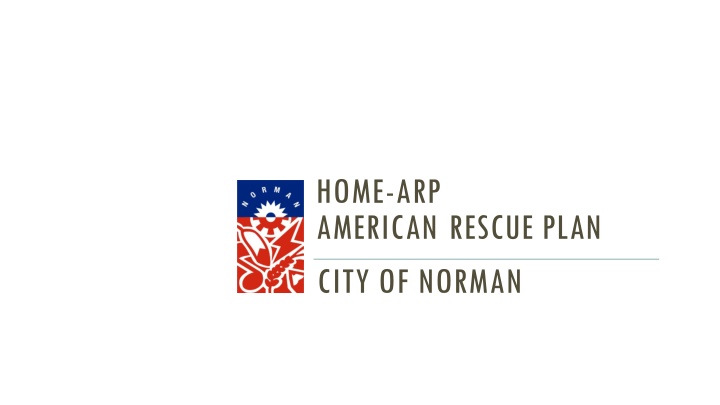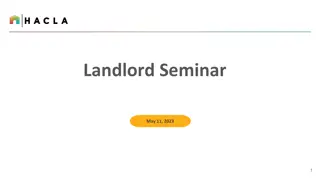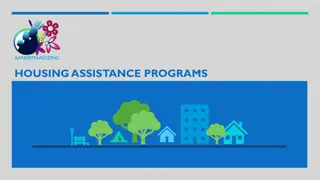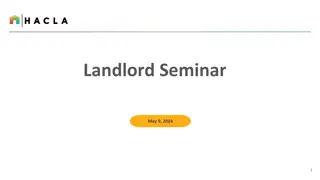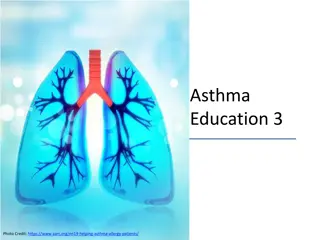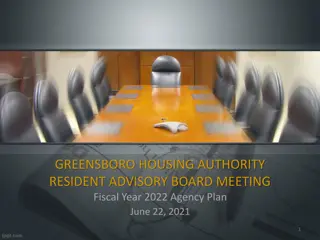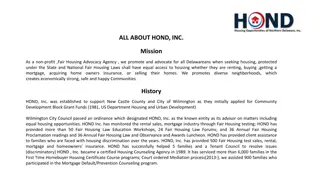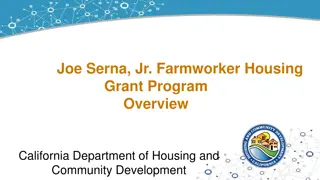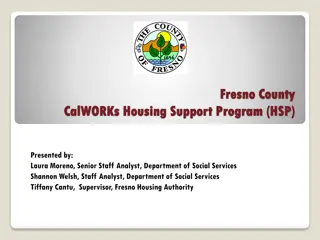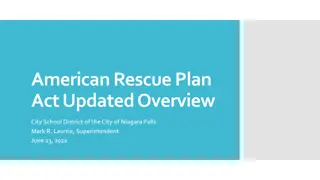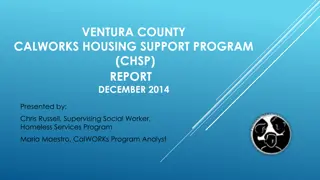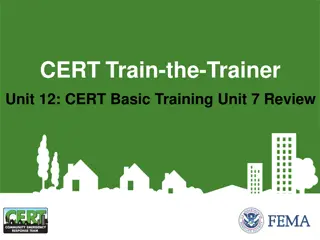American Rescue Plan - City of Norman Housing Assistance Program
This program, part of the HOME-ARP initiative, allocates $5 billion to assist individuals and households who are homeless or at risk of homelessness. The City of Norman has received an allocation of $1,560,908 to address housing needs through consultation, public participation, needs assessment, and goal establishment. The application process involves signing grant agreements, developing an Allocation Plan, and executing programmatic activities. Specific components include needs assessment, gap analysis, consultation, activity requirements, public participation, and certifications.
Download Presentation

Please find below an Image/Link to download the presentation.
The content on the website is provided AS IS for your information and personal use only. It may not be sold, licensed, or shared on other websites without obtaining consent from the author.If you encounter any issues during the download, it is possible that the publisher has removed the file from their server.
You are allowed to download the files provided on this website for personal or commercial use, subject to the condition that they are used lawfully. All files are the property of their respective owners.
The content on the website is provided AS IS for your information and personal use only. It may not be sold, licensed, or shared on other websites without obtaining consent from the author.
E N D
Presentation Transcript
HOME-ARP AMERICAN RESCUE PLAN CITY OF NORMAN
INFORMATIONAL SUMMARY What is HOME-ARP? The Application Process Developing the HOME ARP Allocation Plan Qualifying Populations Summary
SEC. 3205. HOMELESSNESS ASSISTANCE AND SUPPORTIVE SERVICES PROGRAM. Provides $5 billion of supplemental HOME funds to assist individuals or households who are homeless, at risk of homelessness and other vulnerable populations by providing housing, rental assistance, supportive services, and non-congregate shelter. THE HOME- AMERICAN RESCUE PLAN (ARP)
HOME-ARP-CPD Notice 21-10 97 page document with details needed to develop HOME ARP Plan and determine gaps and priorities Allocated via HOME formula, highly targeted to poverty, renters in poverty; cost, availability and condition of housing stock Jurisdictions that qualified for HOME allocation in FY 2021 received HOME-ARP allocation
HOME-ARP ALLOCATION City of Norman $1,560,908 Consultation & Public Participation Needs Assessment and Gaps Analysis Established HOME-ARP Activities HOME-ARP Production Housing Goals Preferences and Referral Methods
APPLICATION PROCESS 01 02 03 04 Sign and return HOME-ARP Grant Agreements to HUD. Once the grant agreement is returned, HUD will release in IDIS, 5% of the total grant amount for a portion of the administration and planning. ($78,045.40 executed 12/14/2021) PJs will develop and submit in IDIS a HOME- ARP Allocation Plan as part of a substantial amendment to their FY 2021 AAP and submit to HUD by 3/31/2023 The City of Norman will begin programmatic execution and distribution of funding utilizing a RFP process once HUD approval of Allocation Plan is complete. Grants expire September 30, 2030. Period of Compliance continues depending on activity type.
DEVELOPING THE HOME-ARP ALLOCATION PLAN
COMPONENTS OF THE ALLOCATION PLAN Needs Assessment and Gap Analysis Consultation HOME-ARP Activities Activity Specific Requirements Public Participation Certifications and SF-424s
CONSULTATION The City of Norman PJ consulted with agencies and services providers whose clientele include HOME-ARP qualifying populations to identify unmet needs and gaps in housing and service delivery systems. The Consultation Process Included: 1. OK504CoC which serves the jurisdictions geographic area 2. Homeless and domestic violence service providers 3. Veteran s groups 4. 5. Public housing agencies Public agencies that address the needs of the qualifying populations 6. Public or private organizations that address fair housing, civil rights, and the needs of persons with disabilities. 7. Consultations were held in person, online survey, and in virtual contexts
The data MUST drive the decision on how HOME- ARP funds will be allocated. NEEDS ASSESSMENT AND GAP ANALYSIS The City of Norman as the PJ conducted a needs assessment and gap analysis, both rooted in data. The analysis included the size and demographics of the qualifying population and the unmet need in housing and services. Data that was part of the Homebase Strategic Plan was updated and included. In addition, the plan identified: 1. Characteristics of housing associated with instability and an increased risk of homelessness; 2. Priority needs for qualifying populations; and, 3. Explained how level of need and gaps in its shelter and housing inventory and service delivery systems was determined.
HOME-ARP ACTIVITIES Describe how a PJ will distribute HOME-ARP funds in accordance with its priority needs. Indicate the amount of HOME-ARP planned for each eligible activity type. Demonstrate that no more than 5% of the allocation will be used for nonprofit organization operating assistance, nonprofit capacity building, and no more than 15% for administrative costs. Include a description on how the characteristics of the shelter and housing inventory, service delivery system, and the needs identified in the gap analysis provided a rationale for the plan to fund eligible activities.
HOME ARP QUALIFYING POPULATIONS At-risk of homelessness, as defined in section 401(1) of the McKinney-Vento Homeless Assistance Act Homeless, as defined in section 103(a) of the McKinney-Vento Homeless Assistance Act In other populations where providing supportive services or assistance under section 212(a) of the Act (42 U.S.C. 12742(a)) would prevent the family s homelessness or would serve those with the greatest risk of housing instability. Fleeing, or attempting to flee, domestic violence, dating violence, sexual assault, stalking, or human trafficking, as defined by the Secretary;
FIVE ELIGIBLE ACTIVITIES PRODUCTION OR PRESERVATION OF AFFORDABLE HOUSING (HOME ELIGIBILITY) TENANT-BASED RENTAL ASSISTANCE (TBRA) (HOME ELIGIBILITY) SUPPORTIVE SERVICES, HOMELESS PREVENTION SERVICES, AND HOUSING COUNSELING (HOME ARP ELIGIBILITY ONLY) PURCHASE AND DEVELOPMENT OF NON- CONGREGATE SHELTER (HOME ARP ELIGIBILITY ONLY) NONPROFIT OPERATING AND CAPACITY BUILDING (HOME ARP ELIGIBILITY ONLY)
WHAT WAS CONSIDERED? The City of Norman, OK504CoC and other community partners collected data to identify the gaps. 1. HMIS data on who is experiencing homelessness in the community 2. Reviewing current community plans or gaps analysis 3. Identifying additional sources of funding for potential projects as needed 4. Development of prioritization tools for potential projects
HOME-ARP funds may be used to acquire, construct and rehabilitate rental housing for occupancy by individuals and families that meet one of the Qualifying Populations. RENTAL HOUSING Permanent Supportive Housing has been identified as the top priority. Funding proposes to construct 12 units of Permanent Housing. HOME ARP funding will be leveraged to the maximum extent to produce additional units. Norman Housing Authority has committed to providing Project Based Rental Assistance for this project which will provide operational funding.
HOME-ARP funds may be used to provide tenant- based rental assistance ( HOME-ARP TBRA ) to individuals and families that meet one of the Qualifying Populations TENANT BASED RENTAL Tenant Based Rental Assistance funds are already being provided by multiple funding sources for the Qualifying Populations. ASSISTANCE
HOME-ARP funds may be used to provide a broad range of supportive services to individuals and families that meet one of the qualifying populations. McKinney-Vento Supportive Services Homeless Prevention Services (ESG Program) Housing Counseling Services SUPPORTIVE SERVICES The 12 units of permanent housing are being designated as permanent supportive housing and will utilize HOME ARP. The Supportive Services will be limited on the tenants of this project to maintain housing stability.
HOME-ARP funds may be used to acquire and develop non-congregate shelter (NCS) for individuals and families that meet one of the Qualifying Populations. NON- CONGREGATE SHELTER NCS provides private units or rooms as temporary shelter to individuals and families and do not require occupants to sign a lease or occupancy agreement. The HOME ARP funding awarded is not sufficient to develop a non-congregate shelter and unlike the PSH rental development, matching funds are not available. In addition there is not an ongoing operational funding source identified.
HOME ARP funds may used (up to 5% of HOME-ARP allocation) to pay operating expenses of CHDOs and other nonprofit organizations that will carry out activities with HOME-ARP funds. NONPROFIT OPERATING AND CAPACITY BUILDING ASSISTANCE A PJ may also use up to an additional 5% of its allocation to pay eligible costs related to developing the capacity of eligible nonprofit organizations to successfully carry out HOME-ARP eligible activities. Although this is an identified need within Norman other funding sources should be utilized. United Way, etc.
ACTIVITY SPECIFIC REQUIREMENTS HOME-ARP Production Goals: Preferences: HOME-ARP Refinancing Guidelines: If a PJ intends to use HOME-ARP funds to refinance existing debt secured by multifamily rental housing that is being rehabilitated with HOME-ARP funds, it must state its refinancing guidelines in accordance with 24 CFR 92.206(b). The plan must estimate the number of affordable rental housing units for qualifying populations that the PJ will produce and describe a specific affordable rental housing production goal and how it will address the PJ s priority needs. The plan must identify whether the PJ intends to give preference to one or more qualifying populations or a subpopulation within one or more qualifying populations for any eligible activity or project. Category 1- Homeless; Chronic Homeless 12 Units Not designated as an eligible activity in the Allocation Plan Permanent Supportive Housing
PREFERENCES/LIMITATIONS/METHODS OF PRIORITIZATION A Preference permits an eligible Qualified Population applicant to be selected for assistance before another eligible qualifying applicant. A preference has been established for Category 1 Homeless; with a subpopulation of Chronically Homeless Chronic Homeless Homeless for a period of one year or more with verified disability A Limitation purposefully excludes an eligible Qualified Population applicant from applying for or receiving assistance No limitations are proposed A Method of Prioritization is the process used to determine how two or more eligible Qualified Population applicants qualifying for preferences are selected for HOME-ARP assistance. Referrals may be made from multiple sources CoC; CCM, DV provider, other entities Waiting list will be utilized Prioritization will be based upon length of time homeless
PRODUCTION OF AFFORDABLE HOUSING $1,226,908 PROGRAM ADMINISTRATION $234,000 SUPPORTIVE SERVICES $100,000 CITY OF NORMAN HOME ARP Allocation Plan Funding Summary
NEXT STEPS OF THE ALLOCATION PLAN Continue to consider consultation opportunities to refine plan Public Comment continues until March 20, 2023 Substantial Amendment and execution of Certifications and SF-424s; March 14, 2023; Submittal to HUD by March 31, 2023 RFP Process for Developers after HUD Approval All Activities completed by 2030
QUESTIONS? CITY OF NORMAN HOME ARP Allocation Plan
an individual or family who lacks a fixed, regular, and adequate nighttime residence; an individual or family with a primary nighttime residence that is a public or private place not meant for human habitation, including a car, park, abandoned building, bus or train station, airport, or camping ground; HUD DEFINITION HOMELESS an individual or family living in shelter designated to provide temporary living arrangements an individual who resided in a shelter or place not meant for human habitation and who is exiting an institution where he or she temporarily resided; an individual or family who will imminently lose their housing, including housing they own, rent, or live in without paying rent, are sharing with others, and rooms in hotels or motels
Multiple Moves: Has moved because of economic reasons two or more times during the 60 days immediately preceding the application for assistance Doubled Up: Is living in the home of another because of economic hardship HUD DEFINITION AT RISK OF HOMELESSNESS Hotel/Motel: Lives in a hotel or motel and the cost is not paid for by charitable organizations or by federal, state, or local government programs for low-income individuals Overcrowded Housing: Lives in a single room occupancy (SRO) or efficiency apartment unit where two or more persons reside or where there are more than one-and-a-half persons per room Income at or below 30% AMI; Lacks sufficient resources to attain housing stability; AND Exiting Institution: Is exiting a publicly funded institution or system of care (e.g., jail, prison, psychiatric hospital, etc.);
